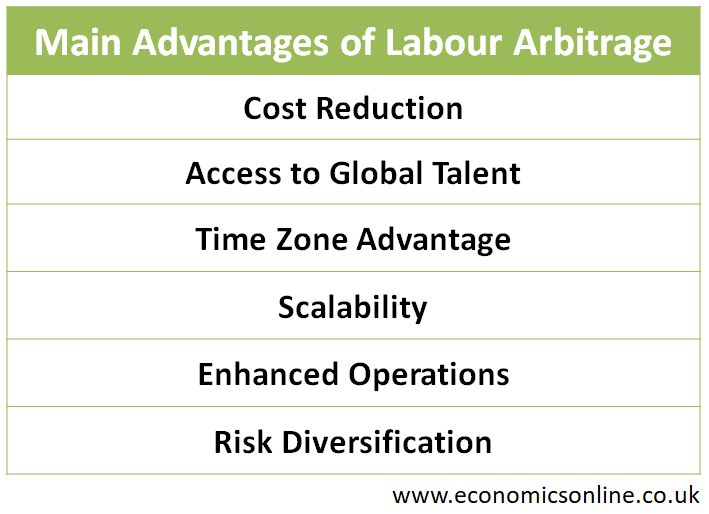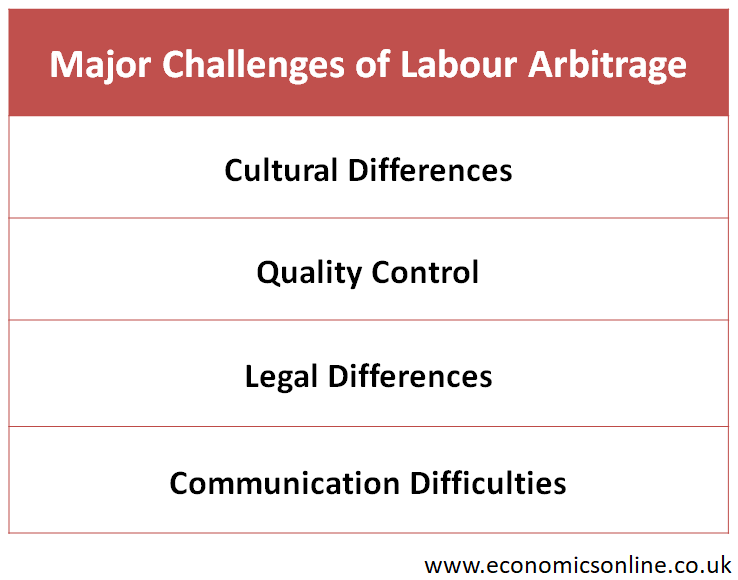
Labour Arbitrage
What is Labour Arbitrage?
Labour arbitrage is the process of finding and utilising low-cost labour to produce goods and services to enhance business efficiency. Typically, it involves relocating certain business processes or functions from one location to another where the same skilled labour can be acquired at a lower cost while maintaining or even improving quality.
Understanding Labour Arbitrage
Some experts define labour arbitrage in narrow terms as follows:
Strictly moving production work from one place to another where the same skill set is available but at a lower cost.
One form involves offshore workers, where companies can employ foreign workers and pay lower wages, payroll taxes, benefits, and/or overtime. Another variation is the use of inexpensive subcontractors in the company's home country rather than hiring staff employees. Yet another form is utilising work visa programmes to bring in low-wage workers.
Traditionally, labour arbitrage involved moving some business operations from one geographical location to another in search of cheaper labour. This was mainly done by manufacturing firms relocating factories from developed countries to less developed ones with cheaper labour.
Today, firms can find low-cost remote workers due to advances in technology and the rise of the gig economy. For example, many firms are outsourcing their customer support operations offshore to countries with lower labour costs, such as India or the Philippines. These remote workers from developing countries provide remote work in the form of customer service, allowing companies to significantly reduce their labor costs.
The Purpose of Labour Arbitrage
The primary purpose of using labour arbitrage is to enhance operational efficiency by reducing labour expenses without compromising the quality of goods and services. Firms can leverage differences in labour costs, skills, and labour availability between geographical regions or different labour markets to achieve cost savings.
Firms maintain competitiveness by enhancing their products and reducing costs. One strategy for cost reduction is labour arbitrage by moving some business operations from a country with a high labor costs to a country with low labor costs.
The History of Labour Arbitrage
Throughout history, firms have sought to control labour costs, so the concept of labour arbitrage is not new. Historically, companies were located near their workforce and remained in those regions for long periods. For example, in the 20th century, some US-based firms began outsourcing their manufacturing operations to Mexico.
Today, the practice of labour arbitrage has become easier than ever due to advances in technology, global access to information, and easy payment methods.
Types of Labour Arbitrage
There are many types of labour arbitrage. Some common types include:
Geographic Labour Arbitrage
Geographic labour arbitrage involves outsourcing work to locations where labour costs are lower than in the home country. For example, a US-based business may want to operate a call centre in a developed country such as the Philippines, where costs are lower. This allows them to take advantage of lower labor costs and lower salaries while providing quality service.
Geographic labour arbitrage can take many forms, including:
Offshoring – Relocating a business function abroad to a low-cost foreign country.
Nearshoring – Relocating a business function abroad to a low-cost neighbouring country.
Onshoring – Bringing back an offshore business function to the home country.
Functional Labour Arbitrage
Functional labour arbitrage involves outsourcing a business function, such as marketing or human resources, to another firm in the same or a different market.
For example, a technology company in one country may outsource its software testing to a specialised testing firm, either in the same country or another, at a lower cost.
Functional labour arbitrage can take many forms, including:
Outsourcing – Entrusting specific business functions to third-party service providers.
Foreign Outsourcing – Giving a specific business functions to independent contractors abroad.
Insourcing – Bringing previously outsourced functions back in-house, which may happen when a firm believes it can handle certain tasks more efficiently internally.
The Driving Forces behind Labour Arbitrage
Several factors have driven the adoption of labour arbitrage. Some of them include:
Advancements in Technology
Advent of the internet and advances in information and communication technology have enabled firms to collaborate seamlessly with remote employees, making labour arbitrage more accessible and practical.
Global Market Expansion
Expanding into new markets often involves setting up local operations or utilising labour in those markets. Labour arbitrage supports market entry by providing access to local knowledge and expertise.
Global Payment Methods
Labour arbitrage often involves cross-border transactions in different currencies. Global payment methods, such as digital payment platforms (PayPal, Stripe), and international banking services have facilitated the seamless transfer of funds across borders. This means that workers in lower-cost regions receive their earnings promptly.
Labour Mobility
Labour arbitrage often relies on the availability of skilled labour in various regions. The access to information and better transportation options have increased labour mobility and, hence, labour arbitrage. Labour mobility, including immigration and work visas, has allowed skilled workers to move to regions with a greater demand for their expertise, supporting the rise of labour arbitrage.
Emergence of Trade Blocs
Regional trade blocs, such as the European Union and the North American Free Trade Agreement (NAFTA), promoted free international trade and labour arbitrage by creating larger integrated markets and reducing trade restrictions.
COVID-19 Pandemic
During the COVID-19 pandemic, firms around the world faced disruptions due to restrictions on the movement of people and products. This pandemic accelerated the trend of labour arbitrage by increasing the need for remote workers for business continuity and cost reduction.
Advantages of Labour Arbitrage

Cost Reduction
One of the major advantages of labor arbitrage is cost reduction. Firms can find highly skilled workers in lower-cost regions willing to work for a fraction of the cost compared to their counterparts in high-cost areas.
Access to Global Talent Pool
Labour arbitrage allows businesses to tap into talent pools in different parts of the world that are not readily available in the home country. This can be especially valuable when specialised skills like software development and graphic design are required.
Time Zone Advantage
By using labour arbitrage, firms can operate around the clock by leveraging time zone differences, leading to increased productivity and faster turnaround times.
Scalability
Labour arbitrage can facilitate quick scaling up or down of operations to meet market demands without the need for extensive recruitment processes. This makes the business more flexible and adaptable to changing market conditions.
Enhanced Operations
Labour arbitrage can lead to better quality and increased speed of operations. Firms can streamline processes, improve productivity, and reduce time-to-market by taking advantage of the availability of skilled labour in different time zones.
Risk Diversification
Diversifying operations across multiple locations can reduce the risk associated with geopolitical instability, natural disasters, or other regional challenges that may disrupt business operations.
Major Challenges of Labour Arbitrage

Cultural Differences
One of the major challenges faced by firms in using global labor arbitrage is the cultural differences of the workers working from other locations. Their language, values, norms, and habits may be different, which might make it a challenging task to manage them effectively. Effective communication and better people management are needed for handling cultural differences.
Quality Control
Another challenge is to maintain consistent quality across geographically dispersed teams. A robust quality control mechanism is needed to ensure that uniform standards are met.
Legal Differences
Navigating labour laws, tax regulations, and compliance requirements in different countries can be complex. Legal experts from respective countries can be hired to ensure full compliance.
Communication Difficulties
Another challenge in using labour arbitrage is the difficulty in communicating with workers located in different time zones. Therefore, firms should use technology solutions and establish clear communication protocols to handle this challenge.
Conclusion
Labour arbitrage is a powerful business strategy for firms seeking to reduce costs, access global talent, and enhance operational efficiency. However, its successful implementation requires addressing some challenges as well. Firms should conduct thorough research to find
the most suitable regions and workers for their specific needs. By using labour arbitrage effectively, firms can gain a competitive advantage through cost reduction and remain profitable in a changing business environment.


